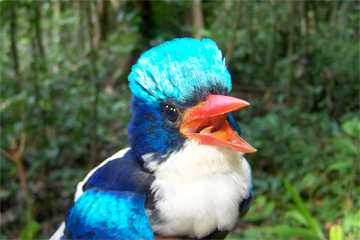As pressures increase on the rich forests of Papua New Guinea, how will biodiversity fare? A new study in mongabay.com’s Tropical Conservation Science attempts to answer this question by looking at how bird species are impacted by slash-and-burn agriculture. While locals have been practicing such agriculture for 5,000 years, rising populations and societal changes are expected to increase the pressure of slash-and-burn agriculture on forests and the species that live there.
Researcher Kateřina Tvardíková surveyed bird populations in primary forest and 7-year-old secondary forest following slash-and-burning in the Wanang Conservation Area along the Ramu River on the island of New Guinea. While abundance of birds was similar in both primary forest and regenerating secondary, species diversity was different. Tvardíková recorded 98 distinct bird species in primary forest and 78 species in secondary, a decline of just over 20%. In addition, 31 of the bird species were found only in primary forest, while 7 species were found only in secondary forest. Finally, important species, such as those that eat insects (insectivores) and those that disperse seeds (frugivores) were found to be “adversely affected by habitat modification […] and they seem to be confined to primary or relatively undisturbed forests,” Tvardíková writes.
 Tanysiptera galatea. Photo by Kateřina Tvardíková |
In regard to conservation the author concludes since any habitat change impacts birds “only the conservation of large, continuous blocks of primary forest would be the ideal course to follow for conserving the diversity of bird species in a given area. However, most of local communities in Papua New Guinea are poor, undeveloped, and thus highly dependent on garden food planted on slash-and-burn plots. To conserve habitat for birds as well as local people, a landscape shared with a large plot of primary forest and land based on shifting agriculture practices would be the best option. […] On the other hand, the conservation of primary forest could conserve extant avian diversity and bring in a sustainable income from ongoing research or tourism.”
CITATION: Tvardíková, K. 2010. Bird abundances in primary and secondary growths in Papua New Guinea: a preliminary assessment. Tropical Conservation Science Vol. 3 (4) :373-388.